The Games That Really Ruined
The Atari 2600
It's common knowledge to those who lived
through the early 1980s part of videogame history that the ruin of the
American videogame market was mostly caused by the glut of Atari 2600
videogame cartridges being released -- in fact, too many games than could meet
the demand for them. While this in itself wasn't bad, what made it bad
was that a good deal of those games were simply bad games -- bad graphics, bad
sound, bad gameplay, bad everything. The badness got to the point where
very few people would even buy the games even when they started getting
discounted to below the $20 mark at most stores. The "quality control"
licensing system that came into effect when Nintendo came to revitalize the
dead game market in the mid-to-late 1980s just simply didn't exist with any of
the parent game console companies of the early 1980s. When Activision, a
third-party game company that formed when several former Atari programmers
decided to break away from Atari when they realized they weren't getting any
royalties or even name recognition from the games they programmed, won their
right to exist after Atari's attempted lawsuit to shut down the company for
making Atari 2600 games outside their control, it opened up a gate that
allowed more companies to develop games for the Atari 2600 -- even those that
produced other game systems that competed with Atari's. Of course,
nobody then had the foresight of seeing how this opened gate of third-party
support would also bring in companies whose only desire was to make bucks from
games first and to make games for playing as an afterthought.
While it's easy to blame the third-party
game companies for allowing the market to crash by putting profits before
gameplay in their marketing strategies, Atari was the main instigator of the
whole mess. Even worse, Atari contributed to the mess of bad games by
promising products that raised home gamers' expectations and then letting them
down when the resulting product delivered little or nothing compared to those
expectations. The following games listed are prime examples of what
Atari offered people that didn't come through when they were released:
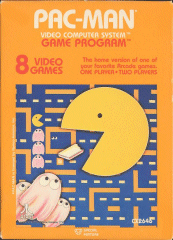 1. Pac-Man -- By 1981, the Atari
2600 enjoyed the distinction of being "the system that brought arcade games
home", with games like Asteroids, Missile Command, and Space
Invaders being the major sellers that enjoyed as much popularity at home
as did their arcade counterparts in the same time period, despite the
differences that existed between the arcade versions and the Atari versions of
these games. The company thought they could do no wrong, and by
early 1982, when Atari announced that a home version of the popular arcade
game Pac-Man was coming for the Atari 2600, home gamers couldn't wait
to get their hands on it. To celebrate its release, Atari had designated
a "Pac-Man day" in April 1982 where Pac-Man and his fellow ghost enemy Blinky
appeared in public in various major cities, passing out player guides for the
arcade Pac-Man game and even visiting area hospitals to greet sick
children.
1. Pac-Man -- By 1981, the Atari
2600 enjoyed the distinction of being "the system that brought arcade games
home", with games like Asteroids, Missile Command, and Space
Invaders being the major sellers that enjoyed as much popularity at home
as did their arcade counterparts in the same time period, despite the
differences that existed between the arcade versions and the Atari versions of
these games. The company thought they could do no wrong, and by
early 1982, when Atari announced that a home version of the popular arcade
game Pac-Man was coming for the Atari 2600, home gamers couldn't wait
to get their hands on it. To celebrate its release, Atari had designated
a "Pac-Man day" in April 1982 where Pac-Man and his fellow ghost enemy Blinky
appeared in public in various major cities, passing out player guides for the
arcade Pac-Man game and even visiting area hospitals to greet sick
children.
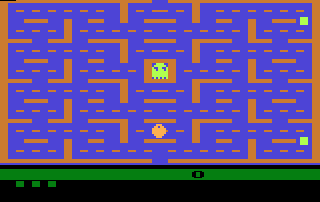 When this was all over and people bought
copies of 2600 Pac-Man, however, things weren't all that happy.
The game only managed to capture the core concept of the coin-op original, but
everything else attached to it was left out. The maze was a boring array
of rectangular passageways, all yellow with a blue background; the ghosts were
all one color and flashed a lot onscreen, turning a vague shade of blue when
the power pellets were eaten; Pac-Man himself didn't move as smoothly as he
did in the arcade; the various bonus items that appeared below the ghost box
were replaced by a rectangular object called a "vitamin" that only awarded 100
points when eaten; the sound effects included an annoying series of dings and
boops, totally unlike the chomping and gulping sounds of its inspiration.
If that wasn't enough, even though the 2600 Pac-Man did include a
two-player option, it didn't offer enough game variations, let alone even good
ones like those in Space Invaders, Asteroids, and Missile
Command -- there was just simply four speed levels for the ghosts and two
for Pac-Man, plus the difficulty switches that controlled how long the
monsters stayed blue when a power pellet was eaten.
When this was all over and people bought
copies of 2600 Pac-Man, however, things weren't all that happy.
The game only managed to capture the core concept of the coin-op original, but
everything else attached to it was left out. The maze was a boring array
of rectangular passageways, all yellow with a blue background; the ghosts were
all one color and flashed a lot onscreen, turning a vague shade of blue when
the power pellets were eaten; Pac-Man himself didn't move as smoothly as he
did in the arcade; the various bonus items that appeared below the ghost box
were replaced by a rectangular object called a "vitamin" that only awarded 100
points when eaten; the sound effects included an annoying series of dings and
boops, totally unlike the chomping and gulping sounds of its inspiration.
If that wasn't enough, even though the 2600 Pac-Man did include a
two-player option, it didn't offer enough game variations, let alone even good
ones like those in Space Invaders, Asteroids, and Missile
Command -- there was just simply four speed levels for the ghosts and two
for Pac-Man, plus the difficulty switches that controlled how long the
monsters stayed blue when a power pellet was eaten.
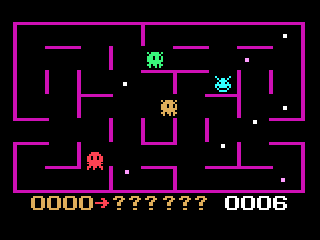 More salt thrown into the wounds created
by this inferior version of Pac-Man would be that before Pac-Man
came out for the 2600, a similar game called K.C. Munchkin was released
for the Odyssey 2 at the tail end of 1981. While it bore vague
similarities to the arcade game that inspired it -- having a sparse collection
of moving dots to eat as well as multiple, editable, and even invisible mazes
-- K.C. Munchkin was deemed too close to imitating Pac-Man to
the point where a legal lawsuit by Atari (who held the home game rights to
Pac-Man) drove the Odyssey 2 game off the market. Also, when
1982 came to a close, Atari brought forth the 5200 system and its version of
Pac-Man which, despite its horizontal orientation of the game screen,
was much closer to the coin-op original than was the 2600 version.
Perhaps the biggest insult to injury was that, though through its Atarisoft
division they would develop home versions of various arcade games for the
various personal computer systems of the early 1980s as well as for the
ColecoVision and Intellivision, Pac-Man showed up for the Intellivision,
but the ColecoVision version was never released and remained undiscovered
until the time of Classic Gaming Expo of 2002. Given the excellent
quality of this unearthed gem of a game, one could almost imagine the feeling
ColecoVision owners (some of whom also were Atari 2600 owners) had of being
shafted yet again by Atari at the time this would have entered the market.
More salt thrown into the wounds created
by this inferior version of Pac-Man would be that before Pac-Man
came out for the 2600, a similar game called K.C. Munchkin was released
for the Odyssey 2 at the tail end of 1981. While it bore vague
similarities to the arcade game that inspired it -- having a sparse collection
of moving dots to eat as well as multiple, editable, and even invisible mazes
-- K.C. Munchkin was deemed too close to imitating Pac-Man to
the point where a legal lawsuit by Atari (who held the home game rights to
Pac-Man) drove the Odyssey 2 game off the market. Also, when
1982 came to a close, Atari brought forth the 5200 system and its version of
Pac-Man which, despite its horizontal orientation of the game screen,
was much closer to the coin-op original than was the 2600 version.
Perhaps the biggest insult to injury was that, though through its Atarisoft
division they would develop home versions of various arcade games for the
various personal computer systems of the early 1980s as well as for the
ColecoVision and Intellivision, Pac-Man showed up for the Intellivision,
but the ColecoVision version was never released and remained undiscovered
until the time of Classic Gaming Expo of 2002. Given the excellent
quality of this unearthed gem of a game, one could almost imagine the feeling
ColecoVision owners (some of whom also were Atari 2600 owners) had of being
shafted yet again by Atari at the time this would have entered the market.
Fortunately, Atari learned enough of a
lesson from this botched release of Pac-Man that, by early 1983, Ms.
Pac-Man made its debut on the 2600, and players noted with much surprise
and delight the things that made Ms. Pac-Man fun to play in the arcades
was preserved with very few flaws on the Atari home version. Of course,
it would still be years before someone would hack this game into Pac-Man
Arcade, and another group of programmers who formed Ebivision would work
on a belated Pac-Man clone of their own called Pesco,
interestingly based off on a more improved home version of its predecessor.
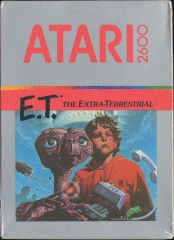 2. E.T. the Extra-Terrestrial --
1982 was a year when movie licenses really began to migrate their way over
into being arcade and home videogame titles. Walt Disney's Tron,
which in itself was a movie about videogames, appeared in the arcades
as two separate videogames (the other game, Discs Of Tron, coming out a
year later) as well as on the Intellivision and the Atari 2600. Parker
Brothers, the board game company, entered into the videogame market with
Star Wars: The Empire Strikes Back for the Atari 2600, which played like
Defender using Imperial Walkers and Snowspeeders in place of the usual
aliens and ships. And Atari, through its former parent company Warner
Communications, scored licenses to develop games based on two popular movies
of the time, Lucasfilm's Raiders Of The Lost Ark and Steven Spielberg's
E.T. the Extra-Terrestrial.
2. E.T. the Extra-Terrestrial --
1982 was a year when movie licenses really began to migrate their way over
into being arcade and home videogame titles. Walt Disney's Tron,
which in itself was a movie about videogames, appeared in the arcades
as two separate videogames (the other game, Discs Of Tron, coming out a
year later) as well as on the Intellivision and the Atari 2600. Parker
Brothers, the board game company, entered into the videogame market with
Star Wars: The Empire Strikes Back for the Atari 2600, which played like
Defender using Imperial Walkers and Snowspeeders in place of the usual
aliens and ships. And Atari, through its former parent company Warner
Communications, scored licenses to develop games based on two popular movies
of the time, Lucasfilm's Raiders Of The Lost Ark and Steven Spielberg's
E.T. the Extra-Terrestrial.
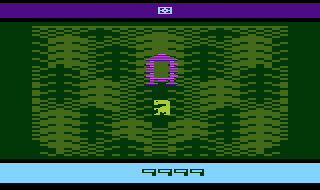 While E.T. was a pretty good movie
to watch -- featuring the story of a young boy befriending an abandoned alien
being who, with the boy's help, salvages various household parts to construct
a "phone" with which to call his people while avoiding being discovered and
studied by a bunch of government agents and scientists -- one can't help but
wonder if this movie really had anything that could be transformed into a
videogame experience. The people at Atari thought it did, and so the
game was made just in time for parents to buy it at Christmastime 1982.
Of course, in order to get the game out by that time, programmer Howard Scott
Warshaw was given only five weeks to fully program the game, leaving very
little time for playtesting or any kind of "quality assurance". The end
result was a game where, for the most part, the player-character kept falling
into pits that he needed to levitate his way out of time and again, and for
children and beginners this meant way too many times. This
problem is not helped by one of the characters, the government agent that
appears in Game 1, who comes along to cause our little alien avatar trouble by
stealing objects such as the "phone" parts from him. The overall result
for Atari was a lot of unsold E.T. cartridges that got crushed and
dumped into a New Mexico landfill and millions of dollars wasted, something
that didn't sit very well with Warner.
While E.T. was a pretty good movie
to watch -- featuring the story of a young boy befriending an abandoned alien
being who, with the boy's help, salvages various household parts to construct
a "phone" with which to call his people while avoiding being discovered and
studied by a bunch of government agents and scientists -- one can't help but
wonder if this movie really had anything that could be transformed into a
videogame experience. The people at Atari thought it did, and so the
game was made just in time for parents to buy it at Christmastime 1982.
Of course, in order to get the game out by that time, programmer Howard Scott
Warshaw was given only five weeks to fully program the game, leaving very
little time for playtesting or any kind of "quality assurance". The end
result was a game where, for the most part, the player-character kept falling
into pits that he needed to levitate his way out of time and again, and for
children and beginners this meant way too many times. This
problem is not helped by one of the characters, the government agent that
appears in Game 1, who comes along to cause our little alien avatar trouble by
stealing objects such as the "phone" parts from him. The overall result
for Atari was a lot of unsold E.T. cartridges that got crushed and
dumped into a New Mexico landfill and millions of dollars wasted, something
that didn't sit very well with Warner.
Interestingly, this didn't stop Atari from
creating more videogames based on movies -- its arcade division, which
eventually broke away from the home videogame and computer division which was
sold to Jack and Sam Tramiel who were from Commodore Business Machines,
produced the Star Wars arcade game that was successful both in the
arcades and in the homes once Parker Brothers got the rights to translate the
game for home game use. It didn't stop 20th Century Fox from having a
shot at producing games based on their movies, which included the rather
questionable Porky's for the 2600. Neither did it stop other
companies from doing the same, even up to this day when another company by the
name of Atari brought forth Enter The Matrix as a cross-ported home
game. However, as far as bad movie-to-game translations go, E.T.
was among the worst of the lot and Atari 2600 owners had to deal with it.
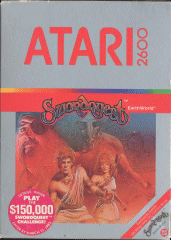 3. The Swordquest series -- Another
Atari 2600 game that became great in the early 1980s was Atari's own
Adventure, which was loosely based on the TSR Games' Dungeons & Dragons
role-playing game series. Though rather primitive compared to its
inspiration, Adventure marked a first as far as a home videogame that
would span multiple interconnected screens and would have objects the player
would use, that along the way would be switched with other objects, to
complete the quest. Another reason for its fame was that its programmer
Warren Robinett left a secret room with his name in it that players could
discover by finding a certain object hidden in one of the many rooms and
bringing it to another place where the object would allow him access into that
secret room. Two other adventure-style games, Superman and
Haunted House, would be released shortly thereafter.
3. The Swordquest series -- Another
Atari 2600 game that became great in the early 1980s was Atari's own
Adventure, which was loosely based on the TSR Games' Dungeons & Dragons
role-playing game series. Though rather primitive compared to its
inspiration, Adventure marked a first as far as a home videogame that
would span multiple interconnected screens and would have objects the player
would use, that along the way would be switched with other objects, to
complete the quest. Another reason for its fame was that its programmer
Warren Robinett left a secret room with his name in it that players could
discover by finding a certain object hidden in one of the many rooms and
bringing it to another place where the object would allow him access into that
secret room. Two other adventure-style games, Superman and
Haunted House, would be released shortly thereafter.
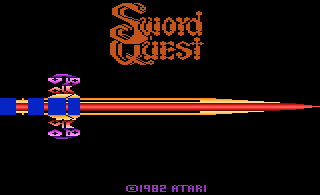 However, with competing systems like the
Intellivision and the Odyssey 2 churning out much more advanced
adventure-style games in the vein of Dungeons & Dragons -- Mattel
having acquired the license from TSR Games to develop games based on and using
the role-playing game title, and Magnavox using a mix of videogame and board
game elements for their Quest For The Rings -- Atari was hard-pressed
to come up with a suitable replacement for their increasingly antiquated
Adventure game. Originally, as far as is known, Atari planned to do
a sequel of sorts to Adventure in 1982; then later in the year, that
plan was modified so that the follow-up game would now be a series in itself
-- the Swordquest series that would span four worlds, each on four
different cartridges, solving puzzles that would unlock clues contained within
the pack-in comics developed by DC Comics (which were pretty good had they
been sold as stand-alone stories) for finishing the game and reaching its
goal. Moreover, to further whet the appetites of serious gamers, each
game in the series would have a playoff contest where the winner of that
contest would be awarded a valuable prize related to the game itself -- a
talisman necklace for Earthworld, a chalice for Fireworld, a
crown for Waterworld, and a Philosopher's Stone for Airworld --
with the final ultimate playoff contest rewarding a valuable sword. All
of the prizes were created by Franklin Mint, at that time a company also owned
by Warner.
However, with competing systems like the
Intellivision and the Odyssey 2 churning out much more advanced
adventure-style games in the vein of Dungeons & Dragons -- Mattel
having acquired the license from TSR Games to develop games based on and using
the role-playing game title, and Magnavox using a mix of videogame and board
game elements for their Quest For The Rings -- Atari was hard-pressed
to come up with a suitable replacement for their increasingly antiquated
Adventure game. Originally, as far as is known, Atari planned to do
a sequel of sorts to Adventure in 1982; then later in the year, that
plan was modified so that the follow-up game would now be a series in itself
-- the Swordquest series that would span four worlds, each on four
different cartridges, solving puzzles that would unlock clues contained within
the pack-in comics developed by DC Comics (which were pretty good had they
been sold as stand-alone stories) for finishing the game and reaching its
goal. Moreover, to further whet the appetites of serious gamers, each
game in the series would have a playoff contest where the winner of that
contest would be awarded a valuable prize related to the game itself -- a
talisman necklace for Earthworld, a chalice for Fireworld, a
crown for Waterworld, and a Philosopher's Stone for Airworld --
with the final ultimate playoff contest rewarding a valuable sword. All
of the prizes were created by Franklin Mint, at that time a company also owned
by Warner.
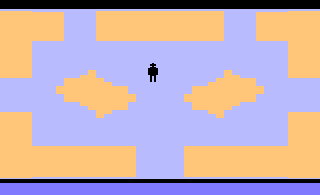 As great as all of this has sounded,
things about this game series started turning bad from the first day players
got Earthworld, the first game of the series. To call that or any
part of the series an "adventure game", let alone a "game", was an abuse of
the term. All it really contained was a player-character that ran around
from room to room, finding and switching around objects contained within the
rooms, and playing various mini-games in order to access others. None of
this really sat well with gamers who hoped to see a game more along the lines
of what was being offered by Mattel and Magnavox being made for the 2600
(truth to tell, Mattel was even in the process of porting their Intellivision
Dungeons & Dragons games for that system).
As great as all of this has sounded,
things about this game series started turning bad from the first day players
got Earthworld, the first game of the series. To call that or any
part of the series an "adventure game", let alone a "game", was an abuse of
the term. All it really contained was a player-character that ran around
from room to room, finding and switching around objects contained within the
rooms, and playing various mini-games in order to access others. None of
this really sat well with gamers who hoped to see a game more along the lines
of what was being offered by Mattel and Magnavox being made for the 2600
(truth to tell, Mattel was even in the process of porting their Intellivision
Dungeons & Dragons games for that system).
While the perceived lack of defined goals
in the game, as well as the perceived lack of anything that would deem these
games an "adventure game", deterred casual gamers from considering getting or
continue playing them, the Swordquest series games at the very least
had some hardcore gamers who attended the playoff contests to win the assigned
prizes of the first two games. But then came the next problem: Warner
was selling off the computer and videogame division of Atari to the Tramiels,
who then sought to streamline the company by eliminating the excessive
spending surrounding its products. The Swordquest series,
unfortunately, became a casualty in this streamlining; indeed, at the point
the Tramiel takeover happened, the third game Waterworld was being sold
as an Atari Game Club exclusive title, which meant very few people would see
it on retail shelves. The playoff contest for Waterworld took
place, though with cash prizes of lesser value than the crown were rewarded
instead. By the end of 1984, however, nothing more was done in the
Swordquest gaming series; the Airworld game was cancelled, and
whatever prizes that would have been awarded in that game's contest and the
final playoff contest reportedly became the property of the Tramiels. DC
Comics never got to create the pack-in comic that would have been included
with the final game in the series.
About two decades later, projects
concerning both the final installment of the Swordquest series and an
actual sequel to the Adventure game have been in the works, though
this time for the Atari 5200. While Swordquest: Airworld ended up being stuck in "development hell", the Adventure II game was eventually released to critical acclaim at AtariAge, even if the game itself seems to repeat elements of the
original game using advanced-style graphics. In 2017, the Swordquest series itself has been resurrected in comic book form to tell a different story related to the original video game saga, about the quest for the unreleased Airworld game.
 1. Pac-Man -- By 1981, the Atari
2600 enjoyed the distinction of being "the system that brought arcade games
home", with games like Asteroids, Missile Command, and Space
Invaders being the major sellers that enjoyed as much popularity at home
as did their arcade counterparts in the same time period, despite the
differences that existed between the arcade versions and the Atari versions of
these games. The company thought they could do no wrong, and by
early 1982, when Atari announced that a home version of the popular arcade
game Pac-Man was coming for the Atari 2600, home gamers couldn't wait
to get their hands on it. To celebrate its release, Atari had designated
a "Pac-Man day" in April 1982 where Pac-Man and his fellow ghost enemy Blinky
appeared in public in various major cities, passing out player guides for the
arcade Pac-Man game and even visiting area hospitals to greet sick
children.
1. Pac-Man -- By 1981, the Atari
2600 enjoyed the distinction of being "the system that brought arcade games
home", with games like Asteroids, Missile Command, and Space
Invaders being the major sellers that enjoyed as much popularity at home
as did their arcade counterparts in the same time period, despite the
differences that existed between the arcade versions and the Atari versions of
these games. The company thought they could do no wrong, and by
early 1982, when Atari announced that a home version of the popular arcade
game Pac-Man was coming for the Atari 2600, home gamers couldn't wait
to get their hands on it. To celebrate its release, Atari had designated
a "Pac-Man day" in April 1982 where Pac-Man and his fellow ghost enemy Blinky
appeared in public in various major cities, passing out player guides for the
arcade Pac-Man game and even visiting area hospitals to greet sick
children. When this was all over and people bought
copies of 2600 Pac-Man, however, things weren't all that happy.
The game only managed to capture the core concept of the coin-op original, but
everything else attached to it was left out. The maze was a boring array
of rectangular passageways, all yellow with a blue background; the ghosts were
all one color and flashed a lot onscreen, turning a vague shade of blue when
the power pellets were eaten; Pac-Man himself didn't move as smoothly as he
did in the arcade; the various bonus items that appeared below the ghost box
were replaced by a rectangular object called a "vitamin" that only awarded 100
points when eaten; the sound effects included an annoying series of dings and
boops, totally unlike the chomping and gulping sounds of its inspiration.
If that wasn't enough, even though the 2600 Pac-Man did include a
two-player option, it didn't offer enough game variations, let alone even good
ones like those in Space Invaders, Asteroids, and Missile
Command -- there was just simply four speed levels for the ghosts and two
for Pac-Man, plus the difficulty switches that controlled how long the
monsters stayed blue when a power pellet was eaten.
When this was all over and people bought
copies of 2600 Pac-Man, however, things weren't all that happy.
The game only managed to capture the core concept of the coin-op original, but
everything else attached to it was left out. The maze was a boring array
of rectangular passageways, all yellow with a blue background; the ghosts were
all one color and flashed a lot onscreen, turning a vague shade of blue when
the power pellets were eaten; Pac-Man himself didn't move as smoothly as he
did in the arcade; the various bonus items that appeared below the ghost box
were replaced by a rectangular object called a "vitamin" that only awarded 100
points when eaten; the sound effects included an annoying series of dings and
boops, totally unlike the chomping and gulping sounds of its inspiration.
If that wasn't enough, even though the 2600 Pac-Man did include a
two-player option, it didn't offer enough game variations, let alone even good
ones like those in Space Invaders, Asteroids, and Missile
Command -- there was just simply four speed levels for the ghosts and two
for Pac-Man, plus the difficulty switches that controlled how long the
monsters stayed blue when a power pellet was eaten. More salt thrown into the wounds created
by this inferior version of Pac-Man would be that before Pac-Man
came out for the 2600, a similar game called K.C. Munchkin was released
for the Odyssey 2 at the tail end of 1981. While it bore vague
similarities to the arcade game that inspired it -- having a sparse collection
of moving dots to eat as well as multiple, editable, and even invisible mazes
-- K.C. Munchkin was deemed too close to imitating Pac-Man to
the point where a legal lawsuit by Atari (who held the home game rights to
Pac-Man) drove the Odyssey 2 game off the market. Also, when
1982 came to a close, Atari brought forth the 5200 system and its version of
Pac-Man which, despite its horizontal orientation of the game screen,
was much closer to the coin-op original than was the 2600 version.
Perhaps the biggest insult to injury was that, though through its Atarisoft
division they would develop home versions of various arcade games for the
various personal computer systems of the early 1980s as well as for the
ColecoVision and Intellivision, Pac-Man showed up for the Intellivision,
but the ColecoVision version was never released and remained undiscovered
until the time of Classic Gaming Expo of 2002. Given the excellent
quality of this unearthed gem of a game, one could almost imagine the feeling
ColecoVision owners (some of whom also were Atari 2600 owners) had of being
shafted yet again by Atari at the time this would have entered the market.
More salt thrown into the wounds created
by this inferior version of Pac-Man would be that before Pac-Man
came out for the 2600, a similar game called K.C. Munchkin was released
for the Odyssey 2 at the tail end of 1981. While it bore vague
similarities to the arcade game that inspired it -- having a sparse collection
of moving dots to eat as well as multiple, editable, and even invisible mazes
-- K.C. Munchkin was deemed too close to imitating Pac-Man to
the point where a legal lawsuit by Atari (who held the home game rights to
Pac-Man) drove the Odyssey 2 game off the market. Also, when
1982 came to a close, Atari brought forth the 5200 system and its version of
Pac-Man which, despite its horizontal orientation of the game screen,
was much closer to the coin-op original than was the 2600 version.
Perhaps the biggest insult to injury was that, though through its Atarisoft
division they would develop home versions of various arcade games for the
various personal computer systems of the early 1980s as well as for the
ColecoVision and Intellivision, Pac-Man showed up for the Intellivision,
but the ColecoVision version was never released and remained undiscovered
until the time of Classic Gaming Expo of 2002. Given the excellent
quality of this unearthed gem of a game, one could almost imagine the feeling
ColecoVision owners (some of whom also were Atari 2600 owners) had of being
shafted yet again by Atari at the time this would have entered the market. 2. E.T. the Extra-Terrestrial --
1982 was a year when movie licenses really began to migrate their way over
into being arcade and home videogame titles. Walt Disney's Tron,
which in itself was a movie about videogames, appeared in the arcades
as two separate videogames (the other game, Discs Of Tron, coming out a
year later) as well as on the Intellivision and the Atari 2600. Parker
Brothers, the board game company, entered into the videogame market with
Star Wars: The Empire Strikes Back for the Atari 2600, which played like
Defender using Imperial Walkers and Snowspeeders in place of the usual
aliens and ships. And Atari, through its former parent company Warner
Communications, scored licenses to develop games based on two popular movies
of the time, Lucasfilm's Raiders Of The Lost Ark and Steven Spielberg's
E.T. the Extra-Terrestrial.
2. E.T. the Extra-Terrestrial --
1982 was a year when movie licenses really began to migrate their way over
into being arcade and home videogame titles. Walt Disney's Tron,
which in itself was a movie about videogames, appeared in the arcades
as two separate videogames (the other game, Discs Of Tron, coming out a
year later) as well as on the Intellivision and the Atari 2600. Parker
Brothers, the board game company, entered into the videogame market with
Star Wars: The Empire Strikes Back for the Atari 2600, which played like
Defender using Imperial Walkers and Snowspeeders in place of the usual
aliens and ships. And Atari, through its former parent company Warner
Communications, scored licenses to develop games based on two popular movies
of the time, Lucasfilm's Raiders Of The Lost Ark and Steven Spielberg's
E.T. the Extra-Terrestrial. While E.T. was a pretty good movie
to watch -- featuring the story of a young boy befriending an abandoned alien
being who, with the boy's help, salvages various household parts to construct
a "phone" with which to call his people while avoiding being discovered and
studied by a bunch of government agents and scientists -- one can't help but
wonder if this movie really had anything that could be transformed into a
videogame experience. The people at Atari thought it did, and so the
game was made just in time for parents to buy it at Christmastime 1982.
Of course, in order to get the game out by that time, programmer Howard Scott
Warshaw was given only five weeks to fully program the game, leaving very
little time for playtesting or any kind of "quality assurance". The end
result was a game where, for the most part, the player-character kept falling
into pits that he needed to levitate his way out of time and again, and for
children and beginners this meant way too many times. This
problem is not helped by one of the characters, the government agent that
appears in Game 1, who comes along to cause our little alien avatar trouble by
stealing objects such as the "phone" parts from him. The overall result
for Atari was a lot of unsold E.T. cartridges that got crushed and
dumped into a New Mexico landfill and millions of dollars wasted, something
that didn't sit very well with Warner.
While E.T. was a pretty good movie
to watch -- featuring the story of a young boy befriending an abandoned alien
being who, with the boy's help, salvages various household parts to construct
a "phone" with which to call his people while avoiding being discovered and
studied by a bunch of government agents and scientists -- one can't help but
wonder if this movie really had anything that could be transformed into a
videogame experience. The people at Atari thought it did, and so the
game was made just in time for parents to buy it at Christmastime 1982.
Of course, in order to get the game out by that time, programmer Howard Scott
Warshaw was given only five weeks to fully program the game, leaving very
little time for playtesting or any kind of "quality assurance". The end
result was a game where, for the most part, the player-character kept falling
into pits that he needed to levitate his way out of time and again, and for
children and beginners this meant way too many times. This
problem is not helped by one of the characters, the government agent that
appears in Game 1, who comes along to cause our little alien avatar trouble by
stealing objects such as the "phone" parts from him. The overall result
for Atari was a lot of unsold E.T. cartridges that got crushed and
dumped into a New Mexico landfill and millions of dollars wasted, something
that didn't sit very well with Warner. 3. The Swordquest series -- Another
Atari 2600 game that became great in the early 1980s was Atari's own
Adventure, which was loosely based on the TSR Games' Dungeons & Dragons
role-playing game series. Though rather primitive compared to its
inspiration, Adventure marked a first as far as a home videogame that
would span multiple interconnected screens and would have objects the player
would use, that along the way would be switched with other objects, to
complete the quest. Another reason for its fame was that its programmer
Warren Robinett left a secret room with his name in it that players could
discover by finding a certain object hidden in one of the many rooms and
bringing it to another place where the object would allow him access into that
secret room. Two other adventure-style games, Superman and
Haunted House, would be released shortly thereafter.
3. The Swordquest series -- Another
Atari 2600 game that became great in the early 1980s was Atari's own
Adventure, which was loosely based on the TSR Games' Dungeons & Dragons
role-playing game series. Though rather primitive compared to its
inspiration, Adventure marked a first as far as a home videogame that
would span multiple interconnected screens and would have objects the player
would use, that along the way would be switched with other objects, to
complete the quest. Another reason for its fame was that its programmer
Warren Robinett left a secret room with his name in it that players could
discover by finding a certain object hidden in one of the many rooms and
bringing it to another place where the object would allow him access into that
secret room. Two other adventure-style games, Superman and
Haunted House, would be released shortly thereafter. However, with competing systems like the
Intellivision and the Odyssey 2 churning out much more advanced
adventure-style games in the vein of Dungeons & Dragons -- Mattel
having acquired the license from TSR Games to develop games based on and using
the role-playing game title, and Magnavox using a mix of videogame and board
game elements for their Quest For The Rings -- Atari was hard-pressed
to come up with a suitable replacement for their increasingly antiquated
Adventure game. Originally, as far as is known, Atari planned to do
a sequel of sorts to Adventure in 1982; then later in the year, that
plan was modified so that the follow-up game would now be a series in itself
-- the Swordquest series that would span four worlds, each on four
different cartridges, solving puzzles that would unlock clues contained within
the pack-in comics developed by DC Comics (which were pretty good had they
been sold as stand-alone stories) for finishing the game and reaching its
goal. Moreover, to further whet the appetites of serious gamers, each
game in the series would have a playoff contest where the winner of that
contest would be awarded a valuable prize related to the game itself -- a
talisman necklace for Earthworld, a chalice for Fireworld, a
crown for Waterworld, and a Philosopher's Stone for Airworld --
with the final ultimate playoff contest rewarding a valuable sword. All
of the prizes were created by Franklin Mint, at that time a company also owned
by Warner.
However, with competing systems like the
Intellivision and the Odyssey 2 churning out much more advanced
adventure-style games in the vein of Dungeons & Dragons -- Mattel
having acquired the license from TSR Games to develop games based on and using
the role-playing game title, and Magnavox using a mix of videogame and board
game elements for their Quest For The Rings -- Atari was hard-pressed
to come up with a suitable replacement for their increasingly antiquated
Adventure game. Originally, as far as is known, Atari planned to do
a sequel of sorts to Adventure in 1982; then later in the year, that
plan was modified so that the follow-up game would now be a series in itself
-- the Swordquest series that would span four worlds, each on four
different cartridges, solving puzzles that would unlock clues contained within
the pack-in comics developed by DC Comics (which were pretty good had they
been sold as stand-alone stories) for finishing the game and reaching its
goal. Moreover, to further whet the appetites of serious gamers, each
game in the series would have a playoff contest where the winner of that
contest would be awarded a valuable prize related to the game itself -- a
talisman necklace for Earthworld, a chalice for Fireworld, a
crown for Waterworld, and a Philosopher's Stone for Airworld --
with the final ultimate playoff contest rewarding a valuable sword. All
of the prizes were created by Franklin Mint, at that time a company also owned
by Warner. As great as all of this has sounded,
things about this game series started turning bad from the first day players
got Earthworld, the first game of the series. To call that or any
part of the series an "adventure game", let alone a "game", was an abuse of
the term. All it really contained was a player-character that ran around
from room to room, finding and switching around objects contained within the
rooms, and playing various mini-games in order to access others. None of
this really sat well with gamers who hoped to see a game more along the lines
of what was being offered by Mattel and Magnavox being made for the 2600
(truth to tell, Mattel was even in the process of porting their Intellivision
Dungeons & Dragons games for that system).
As great as all of this has sounded,
things about this game series started turning bad from the first day players
got Earthworld, the first game of the series. To call that or any
part of the series an "adventure game", let alone a "game", was an abuse of
the term. All it really contained was a player-character that ran around
from room to room, finding and switching around objects contained within the
rooms, and playing various mini-games in order to access others. None of
this really sat well with gamers who hoped to see a game more along the lines
of what was being offered by Mattel and Magnavox being made for the 2600
(truth to tell, Mattel was even in the process of porting their Intellivision
Dungeons & Dragons games for that system).